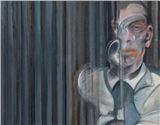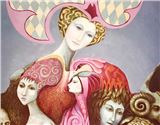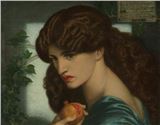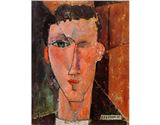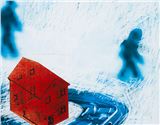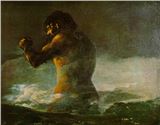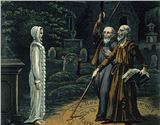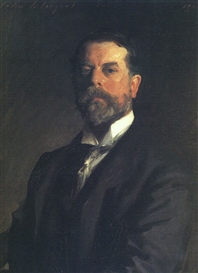Art on Computers: Emulating Tradition with Georg Ireland, Portrait Artist
Georg Ireland uses Rebelle, a realistic painting software, to honor traditional craftsmanship while embracing the possibilities of new technology
Abigail Leali / 黑料不打烊
30 May, 2025

The age of computers has brought about the rise and fall of countless industries – and the creative sphere has been among those most affected. Computer-generated imaging has become the animation standard, and Adobe Creative Cloud has replaced older methods of hand-crafting a design’s graphics, text, and composition. Meanwhile, many craftspeople have found themselves priced out of their fields by cheaper, mathematically precise, and reproducible manufacturing techniques, from assembly lines to 3D printing. On the surface, it can seem as if there isn’t much room for traditional arts and crafts in a machine-driven world.
Still, in recent years, we have seen a resurgence of artists turning to computers to introduce these techniques to a new generation, many of whom have flocked to the “old ways” as a reprieve from a tech-saturated world. Social media is full of calming, “aesthetic” videos of people mixing paint from pigments, forming clay vases on pottery wheels, whittling sticks into little statues, drafting paper patterns for custom dresses, and so on. For younger people who have never known a world without computers and smartphones, these videos hint at something more profound and tangible in the human experience.
Georg Ireland, Laura, 2024.
What happens, then, when these two worlds collide – modern tools mixing with traditional techniques? I’m sure many examples come to mind. I often think, for instance, of animation studios like Studio Ghibli, which relies primarily on hand-drawn frames to craft its stunning movies but will turn to CGI to enhance scenes that may be difficult to capture by hand. When tempered by a human touch, the effect of computer-based art can be electric.
There is one computer art program, however, that has long interested me, not only for its unique approach to digital art but for the artistry intrinsic in the program itself. Rebelle is a “real media paint software” that strives to emulate traditional media as closely as possible. It features realistic paper textures, drawing and painting options ranging from pen and pastels to oils and — perhaps most impressively – watercolors. The paints interact realistically with the paper, and the artist controls the wetness, tilt, brush fill, and several other real-world variables. This realism, it pairs with tools that have become standard for digital art programs, such as clipping masks, blending modes, and color selectors.
Even with these uniquely digital tools, many artists who specialize in Rebelle craft pieces that, on a screen, look almost indistinguishable from real-world art pieces – and that achieve similar heights of achievement.
I have been following Rebelle for many years now, and among the many excellent artists who use it, one whose work has stood out most is . Based in Germany, he uses the program to create emotive portraits that emphasize dynamic and precise brushwork, along with color schemes that create engaging contrast.
Georg Ireland, Self Portrait, 2024.
As realistic as the portraits look, they are entirely digital, and it is immediately apparent that Ireland has spent years honing his skills with the Rebelle program. Yet for most of his life, he worked primarily with traditional media – and as a hobbyist, at that. While he began experimenting with digital art in 2008 with Corel Painter (another realistic painting software), it wasn’t until he retired from his career as a lawyer and later insurance worker that he had time to devote himself to his passion.
Though initially skeptical of digital art’s capacity to bring to life his vision, he came to see its value over time. One reason in particular was enticing: He didn’t have to clean any brushes. As minor an issue as it may seem, cleaning brushes can be a laborious process – one that would sometimes take up so much of his limited painting time that it kept him from doing it at all. As he continued taking both traditional and digital art classes in his spare time, he gravitated more and more to implementing his traditional training on Corel and, later, Rebelle.

While Ireland does paint landscapes and seascapes, he is best known for his portraiture. Even within a few years of pursuing painting as a full-time passion, he has already been recognized with several awards from Rebelle and Corel, and his work has been featured as some of the primary marketing material for each of the software’s updates since 2021. Over the years, there have been countless influences on his artistic style, but among the most prominent are Richard Schmid and John Singer-Sargent, whose visual depth and relational qualities are present throughout his work. He is also friends with other artists, such as Torsten Wolber, whose traditional oil paintings have inspired and impacted him.
Georg Ireland, Kira, 2025.
The digital sphere is also the perfect place for experimentation. Ireland tries to avoid using multiple layers or the “undo” button to give the painting a more human touch. Still, if he wants to try something he’s not sure will work, he can simply add another layer to test it. “For me,” he says,
the creative process is an experiment, a game, a testing of new techniques, forms or concepts. It's not always just about the result, but about the process itself. But it is also the search for the right expression. Sometimes I know exactly what I want to paint, but the canvas doesn't cooperate. And then there are moments when my hand simply leads the way and suddenly, I see something that I never planned but is just right. It is always fascinating to see how a painting develops from start to finish.
Much of his work is for his personal enjoyment (the beauty of the pensioner’s life!), but he also takes commissions that allow him to branch into themes and subject matter he wouldn’t typically pursue. One of his favorite aspects of digital art is how accessible it makes his pieces. Digital dissemination and high-quality prints make it possible for almost anyone to see and own one of his pieces.
Georg Ireland, Taylor, 2022.
Ultimately, despite the very different process from traditional art, which required Ireland to relearn how to craft the perfect brushstroke in the absence of haptic feedback, Rebelle has offered him the opportunity to hone his skills and gain recognition in a field that might otherwise have been out of reach due to the difficulties of maintaining a traditional art studio.
For some who fear technology’s ongoing encroachment into the arts, painters like Ireland might provide some hope that all these changes are not exclusively dangerous. Ireland is careful to distinguish the work he does from photo manipulation or AI, which often involve very little human touch and, in many cases, obscure art’s true meaning and purpose. While computers can threaten human creativity, they have also opened the door for people like him to pursue a passion that may otherwise have been left unfulfilled.
Surely, much of Ireland’s work could be done with a brush and prepared canvas – but that is, in a way, the point. For him, as for many Rebelle and Corel users, the drawing tablet has not replaced the paintbrush; rather, it has become a way to honor time-honored styles and techniques and bring a small piece of “reality” into the intangible digital sphere.
For more on auctions, exhibitions, and current trends, visit our Magazine Page

 ARTISTS
ARTISTS
